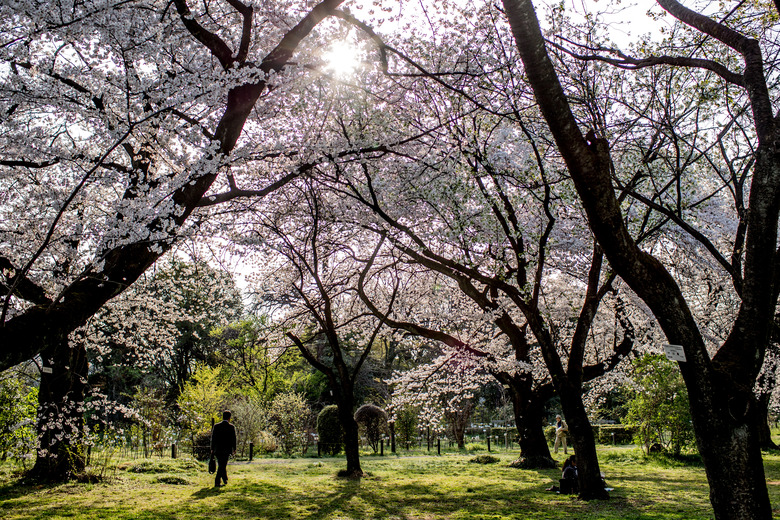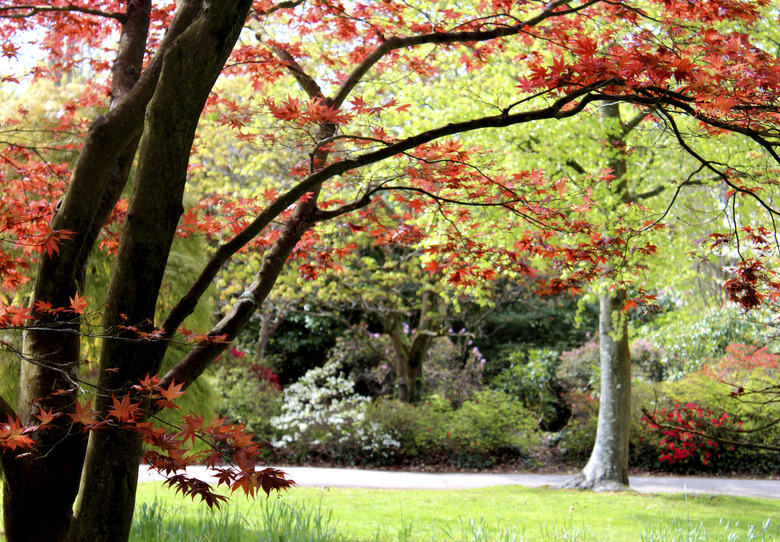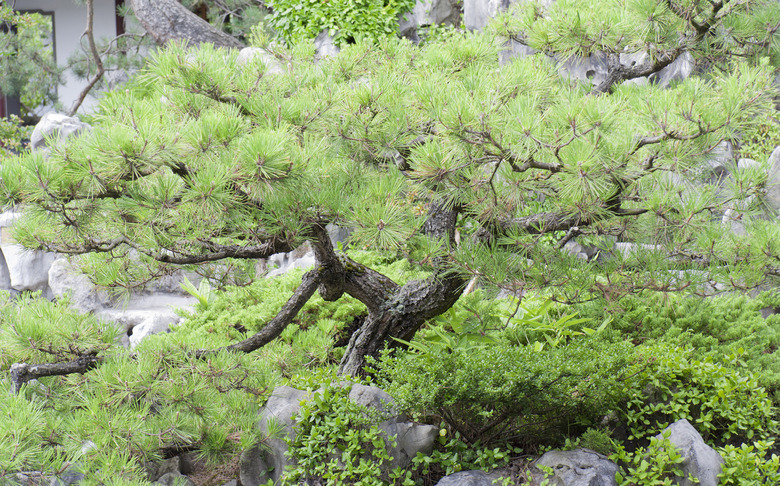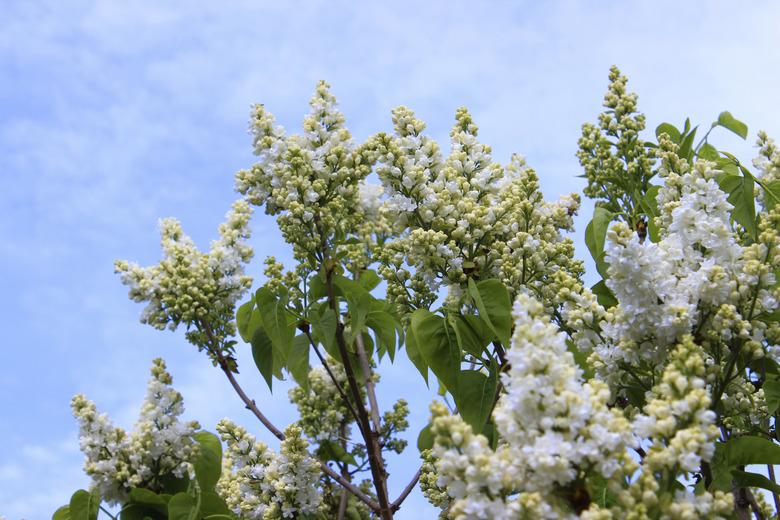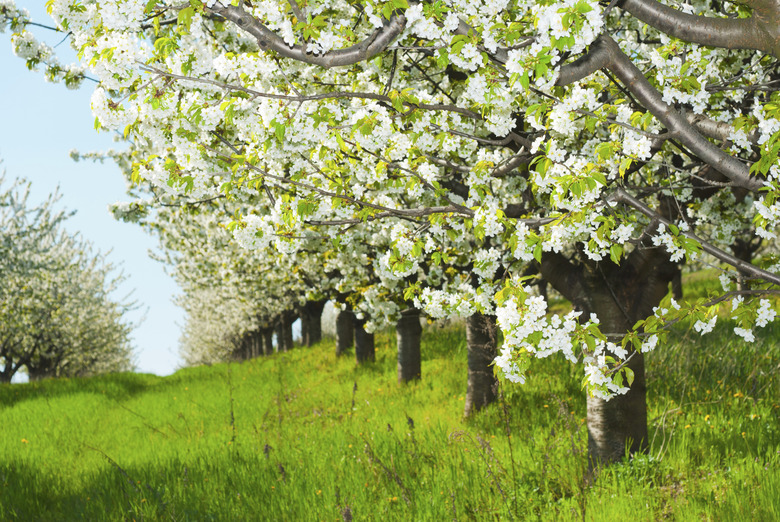List Of Japanese Trees
Gardens have been an important part of Japan's history, with archaeological remains of sixth century palace gardens in evidence. Japanese gardeners developed many tree cultivars and hybrids during centuries of plant breeding, and they have been introduced to other countries. Native species of Japanese trees also grow in gardens worldwide. Japan has a mostly temperate climate, with U.S. Department of Agriculture plant hardiness zones ranging primarily from 3 through 8, with some coastal areas in zone 9.
Deciduous Varieties
Japanese maple (Acer palmatum) and Japanese zelkova (Zelkova serrata) are both deciduous trees, losing their leaves for winter. Japanese maple is usually 10 to 25 feet tall and hardy in USDA zones 5 through 8. Many cultivars exist, with some growing 40 feet tall. In most cultivars, the palmate, five- to nine-lobed leaves provide vivid fall coloration of reddish purple, yellow and bronze. Japanese maple grows best in an area protected from winds and late frosts, and where it receives dappled shade. Japanese zelkova, also hardy in USDA zones 5 through 8, is suitable as a shade or street tree and requires full sun. This member of the elm family reaches 50 to 80 feet tall and as wide. It has few problems and is resistant to Dutch elm disease. The disease kills American elm (Ulmus americana), which otherwise is hardy in USDA zones 2 through 9.
- Gardens have been an important part of Japan's history, with archaeological remains of sixth century palace gardens in evidence.
- Japanese zelkova, also hardy in USDA zones 5 through 8, is suitable as a shade or street tree and requires full sun.
Evergreen Types
Two kinds of Japanese evergreen trees are common in cultivation: Japanese black pine (Pinus thunbergii) and Japanese white pine (Pinus parviflora). Japanese black pine is native to coastal Japan and grows 20 to 60 feet tall and 12 to 20 feet wide. Its long, dark-green needles contrast with its whitish, new terminal branch growth. The tree has a conical shape and is hardy in USDA zones 5 through 8. Also conical when young, Japanese white pine develops a flattened canopy with age. Its needles are typically blue or bluish-green and are stiff and twisted. This tree grows 25 to 50 feet tall and wide in USDA zones 4b through 7a. Both pines are traditional bonsai subjects and require full-sun exposure.
- Two kinds of Japanese evergreen trees are common in cultivation: Japanese black pine (Pinus thunbergii) and Japanese white pine (Pinus parviflora).
- Also conical when young, Japanese white pine develops a flattened canopy with age.
Showy Flowering Specimens
Some Japanese trees produce ornamental flowers. One example is Japanese tree lilac (Syringa reticulata), which grows either as a small tree or large shrub, having a maximum height of 30 feet and a spread of 15 feet. Creamy white flowers that smell something like privet flowers appear in large clusters at the plant's branch ends in early summer. Shape a Japanese tree lilac as a multi-trunked or single-trunked specimen. Its dense canopy is rounded. Well-suited as an accent plant, patio tree or street tree, Japanese tree lilac is hardy in USDA zones 4 through 7a and needs a full-sun site. Another small tree or large shrub that offers ornamental flowers is Oyama magnolia (Magnolia sieboldii). Its large, white, fragrant, nodding flowers are centered by a mass of crimson stamens. The flowers are followed by oval, 3-inch-long pink fruits, and the tree's leaves turn deep yellow in fall. Growing 10 to 15 feet tall and wide, Oyama magnolia requires partial shade to full sun and is hardy in USDA zones 6 through 8.
- Some Japanese trees produce ornamental flowers.
- Creamy white flowers that smell something like privet flowers appear in large clusters at the plant's branch ends in early summer.
Newsworthy Offerings
Flowering cherry trees (Prunus spp.) made international news in 1912 when the Japanese government donated thousands of them on behalf of the City of Tokyo to the United States for planting in Washington, D.C. The two main varieties are "Kwanzan" (Prunus serrulata "Kwanzan") and "Yoshino" (Prunus x yedoensis). "Kwanzan" is hardy in USDA zones 5b through 9a and grows 15 to 25 feet tall and wide. "Yoshino" is hardy in USDA zones 5 through 8, reaching 50 feet tall and 40 feet wide. More plantings followed the original ones in Washington, D.C.. Many varieties and hybrids have been developed from the Japanese flowering cherry, and the trees hold a special place in Japanese culture.
- Flowering cherry trees (Prunus spp.)
- made international news in 1912 when the Japanese government donated thousands of them on behalf of the City of Tokyo to the United States for planting in Washington, D.C.
- The two main varieties are "Kwanzan" (Prunus serrulata "Kwanzan") and "Yoshino" (Prunus x yedoensis). "
References
- Japan-Guide.com: Types of Gardens
- Pacific Bulb Society: Japanese Plant Hardiness Zones
- Missouri Botanical Garden: Acer Palmatum
- Clemson Cooperative Extension: Maple
- Missouri Botanical Garden: Zelkova Serrata
- Missouri Botanical Garden: Pinus Thunbergii
- U.S. Department of Agriculture, Forest Service: Pinus Parviflora, Japanese White Pine
- U.S. Department of Agriculture, Forest Service: Syringa Reticulata, Japanese Tree Lilac
- Missouri Botanical Garden: Magnolia Sieboldii
- U.S. National Park Service: Cherry Blossom Festival — History of the Cherry Trees
